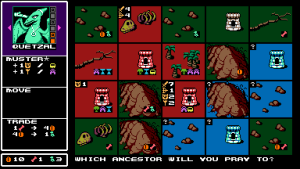
It may appear unusual to assert that a collection brimming with challenging twitch action games, intricate arcade puzzles, and a comprehensive narrative RPG lacks nostalgia. However, UFO 50, a compilation featuring 50 retro-inspired games of diverse scales, is replete with unexpected elements. While it certainly draws from various influences—Magical Garden is reminiscent of Snake, and Valtress resembles a blend of Kid Icarus and Downwell—it is committed to emulating the aesthetics and sounds of earlier gaming eras. Notably, UFO 50 also reflects the creative spirit of 2000s game jam culture, rather than solely relying on the nostalgia of the NES. The simplicity of each game contributes to a broader and deeper experience, aiming to extract maximum potential from every pixel. UFO 50 fosters a sense of expansive possibility, suggesting that video games can encompass a vast array of experiences. This notion has often existed on the periphery of the gaming world, making it difficult to categorize as a conventional form of nostalgia. In an industry where major corporations promote the latest trends as the definitive representation of gaming, it is invigorating to simultaneously reflect on both the past and the future.
To my mind, UFO 50’s retro aesthetic serves two purposes. First, it keeps games resource-light. Each game is bare in construction, often lacking explicit tutorialization. Most games have a mere six buttons to play with. It maintains the mysterious workings and iterations of arcade games, without the quarter-munching business model. Each game can only be so big lest it outscope the rest. So, the focus is on mechanical density and complexity, on the kind of replayability that comes from careful design, not endless racks of content. The feeling is closer to setting up an emulator loaded with cult classics than to a childhood memory of getting an 8-bit console for Christmas.
Secondly, the retro aesthetic emphasizes the unique choices and concepts inherent in each game. Certain titles within UFO 50, such as Campanella and its sequel, as well as The Big Bell Race, exhibit clear connections to one another. In contrast, others, including the surreal Waldorf’s Journey and the strategic Avianos, seem to originate from entirely different realms. Nevertheless, all the games in UFO 50 share a common foundation: pixels, code, and a limited number of buttons. This simplicity, however, opens up a vast array of possibilities, making each new feature feel extraordinary.

One of the most notable games in UFO 50 is Mooncat, a platform puzzler that utilizes a two-button control scheme. During the initial playthrough, a significant portion of the experience revolves around understanding the mechanics of the game. Players take control of a bipedal creature, likely the eponymous mooncat, which navigates through various movements and timings dictated by its two buttons. The game features a jump, a ground pound, a brief dash, and basic lateral movement; however, these actions are executed in an unconventional manner, rendering any preconceived notions of typical video game mechanics irrelevant. The artistic style is both whimsical and peculiar, infused with an element of menace. Vibrant green fields inhabited by small creatures transition into ancient burial sites adorned with colossal skeletons and arid deserts beneath a crimson sky. This game presents a challenge to envision as a commercial product, even in the context of 1985. Its existence alongside more traditional games highlights the experimental nature of UFO 50. While some of its titles may adhere to genre norms, many do not.
UFO 50’s meta-narrative is aptly centered on rediscovering a neglected catalog rather than revisiting well-known classics. The introductory “cutscene” depicts members of the UFO 50 team uncovering the game’s fictional console within an old storage unit. This scenario is not a celebrated moment in gaming history, nor is it something one might readily find in a local retro shop; it is largely ignored. This choice to begin in a storage unit, as opposed to a quaint shop or a meticulously curated collection, sets it apart from other retro compilations like The Sega Master Collection, which features a main menu reminiscent of a childhood bedroom. In contrast, UFO 50’s main menu emphasizes the games themselves, presenting cartridges that are not neatly displayed on a shelf but rather ensconced in cobwebs. When a player selects a game that has not yet been played, it is dusted off. While this approach is undeniably charming, it evokes the sense of an archive more than that of a basement.
All this is to say, UFO 50 presents itself as an excavation rather than a return to the past. It wants you to discover, not to rediscover. There is no past to return to. Even in UFO 50’s internal fiction, you are playing these games right now, not in some imaginary 1980s. The emphasis on discovery has a double effect: It helps these games feel alive and helps you approach them on their own merits, not just as mere echoes of the past. It is uncloying, dignified, but still playful.

A significant reduction has been made to UFO 50, yet it remains quite extensive, encompassing a total of 50 distinct games. Each title could warrant an in-depth discussion on its own. The abundance lies in the richness of experiences and the variety it offers. In contrast to many high-budget video games, which often present large-scale environments but repetitively focus on similar tasks leading to a singular overarching objective, UFO 50 provides a unique experience with each game. Although completing all of UFO 50’s offerings may require over a hundred hours, each game stands as a complete and fulfilling experience in its own right.
There’s some melancholy to UFO 50’s unique position. Critic Liz Ryerson describes UFO 50 as “about a sort of lost innocence for games and what they could be before they became a massive dominant cultural industry.” Now video games, or at least the business of video games, is a relatively narrow set of genres. Open worlds have codified into Ubisoft bloat. Live-service games chase the brand integration of Fortnite or the expansion of Genshin Impact. Call of Duty has been the dominant first-person shooter for well over a decade. Mainstream games have lost their experimental edge. UFO 50 is perhaps the biggest scale that an experimental game can operate in. That’s still pretty small.
UFO 50 deserves recognition and celebration. I have frequently expressed my disappointment regarding the scarcity of creators akin to Martin Scorsese in the realm of video games. My desire is not for an increase in crime dramas or themes of Catholic anxiety, but rather for more game developers who hold a deep appreciation for the history of video games. I seek developers who reference the past not from a place of superficial nostalgia, but from a sincere respect for it, a willingness to learn from it, and an intention to enrich our connection to it rather than to supplant or enhance what has come before. UFO 50 represents a modest yet assured and thrilling advancement in this regard.
